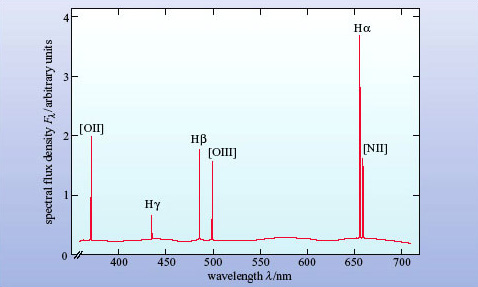2 The spectra of galaxies
2.1 What contributes to the spectra of galaxies?
This section reviews what you may already know about the spectra of galaxies. The topic will later be developed further to help you appreciate the spectra of active galaxies.
The four main constituents of a galaxy are dark matter, stars, gas and dust.
Even though dark matter is the main constituent of a galaxy, it does not contribute to the spectrum of the galaxy so we need not consider it any further. The spectrum of a galaxy contains contributions from stars, gas and (sometimes) dust.
The spectrum of a star normally consists of a continuous thermal spectrum with absorption lines cut into it (Figure 1). It is possible to learn a lot about the star from a study of these absorption lines.

What can be learned about a star from its absorption lines? The strengths and widths of the absorption lines contain information about the star's chemical composition, surface temperature and luminosity. By looking for Doppler shifts in the lines you can measure radial velocity and, if the Doppler shifts are periodic in time, you can detect the binary nature of a star.
The gas in a galaxy is partly visible in the form of hot clouds known as HII regions. Such regions are usually only seen where there is ongoing star formation, and so are prominent in spiral and irregular galaxies. The optical spectrum of an HII region consists of just a few emission lines, as can be seen in Figure 2. HII regions can make a substantial contribution to the spectra of galaxies because they are very bright. The only other gaseous objects in a normal galaxy to emit at optical wavelengths are supernova remnants and planetary nebulae, and these are faint compared with HII regions.

The dust component of a galaxy, being relatively cool, does not lead to any emission features in the optical spectrum of a galaxy. The main effect of dust at optical wavelengths is to absorb starlight. However, dust can emit strongly at far-infrared wavelengths (λ of about 100 μm).
As a rule, optical absorption lines result from stars, and optical emission lines result from hot gas.
The spectra of stars and HII regions extend far beyond the optical region. The Sun, for example, radiates throughout the ultraviolet, X-ray, infrared and radio regions of the electromagnetic spectrum. The majority of the Sun's radiation is concentrated into the optical part of its spectrum but, as you will shortly see, this is not the case for active galaxies, for which it is necessary to consider all the observed wavelength ranges. We shall call this the broadband spectrum to distinguish it from the narrower optical spectrum.
The word optical means visible wavelengths plus the near ultraviolet and near infrared wavelengths that can be observed from the ground, and extends from 300 to 900 nm. The optical spectrum is just one part of the broadband spectrum albeit an important part. The spectrum of a normal galaxy is the composite spectrum of the stars and gas that make up the galaxy. Some of the absorption lines of the stars and some of the emission lines of the gas can be discerned in the galaxy's spectrum. As well as being able to work out the mix of stars that make up the galaxy, astronomers can measure the Doppler shifts of these spectral lines and so work out the motions within the galaxy as well as the speed of the galaxy through space.
In the case of active galaxies, the spectrum shows features in addition to those of normal galaxies, and it is from these features that the active nucleus of the galaxy can be detected.
